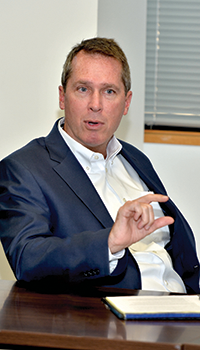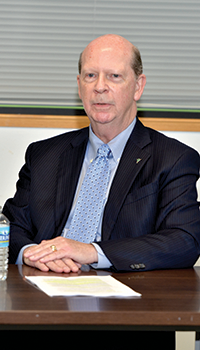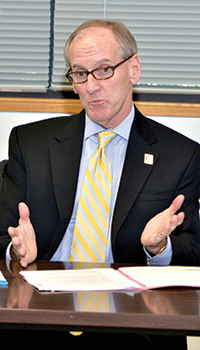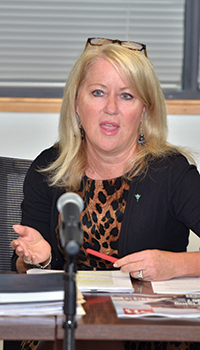The health-care squeeze
Hospital executives say they don’t operate in a free market
The health-care squeeze
Hospital executives say they don’t operate in a free market
Virginia hospital executives want to make one point abundantly clear: They do not operate in a free-market environment.
Hospitals treat all patients regardless of ability to pay, and they serve Medicare and Medicaid patients despite being paid less than the cost of care.
“We’re fundamentally different. You’re not going to get a highway construction firm to build the state’s highways [for less than] what it costs them,” says James B. Cole, the president and CEO of Virginia Hospital Center in Arlington. “We care for anyone whether they can pay a nickel or not, and that’s not standard in the business world.”
Cole, past chair of the Virginia Hospital & Healthcare Association board, was one of four VHHA officers who sat down with Virginia Business editors to discuss issues facing their industry.
The others were: Mary N. Mannix, president and CEO of Augusta Health in Fishersville, who is the current chair of the VHHA board; Michael V. Gentry, chief operating officer at Sentara Healthcare in Norfolk and the board’s vice chair; and Mark H. Merrill, president and CEO of Valley Health in Winchester who is the board’s secretary-treasurer.
During the discussion, the hospital officials said they have not given up hope of expanding Medicaid in Virginia despite stiff resistance from the General Assembly. In fact, a plan proposed by VHHA during the past legislative session remains on the table. Under that proposal, money generated from a provider assessment on hospitals would be used to draw down matching federal funds for Medicaid.
Because of the losses hospitals have incurred from charity care and low payments from government programs, their profitable services, such as surgery and imaging, have to subsidize unprofitable services.
That is one reason, the executives say, they oppose the elimination of Virginia’s certificate of public need law (COPN). Without COPN, competitors would be allowed to “cherry pick” profitable services in a region without being required to serve all patients regardless of their ability to pay, the executives say.
“What happens with certificate of need is that it helps distribute those services evenly, and it also protects those organizations that have a high amount of charity care or high number of Medicaid patients,” Mannix says. “It protects those organizations from losing those services that offset those that are reimbursed below cost.”
Virginia business editors Robert Powell and Paula C. Squires talked with the hospital executives on Aug. 30 at VHHA’s headquarters in Glen Allen.
Virginia Business: What would Medicaid expansion in Virginia mean for your hospitals? Have you given up on that ever happening?
Cole: There is a lot of difference of opinion about Medicaid expansion nationally and probably among our members and certainly within the General Assembly … [[Under the Affordable Care Act, reductions in Medicare funding to hospitals treating indigent patients], by 2022, I think are going to grow to about $1 billion less than we would have had otherwise. So that’s having a tremendous impact. If you pile on top of that the effect of sequestration [across the board federal budget cuts], it’s placing tremendous cost pressure on all hospitals, and especially hit hard are the rural hospitals. When we look at the issue of Medicaid expansion, it’s certainly a way to increase coverage for more folks, and it’s something that we initiated a discussion about last year. We’re prepared to continue that, with all parties, to try to find a way, within that Virginia mode, to bring about Medicaid expansion. Certainly a number of other states with differing sort of prevailing political opinions have found ways to expand, even Indiana Governor Mike Pence’s state. Obviously he’s a Republican nominee for vice president.
Mannix: [The objective is] to reach 400,000 of our fellow human beings that don’t have access to care. They are falling into this gap where they’re not eligible for Medicaid, yet they don’t have the financial means to be able to sustain their health, pay their bills and pay a premium for insurance. Their access to health care becomes very limited. We care about those Virginians, and we haven’t given up.
Merrill: I would just add our health system operates in two states: Virginia and West Virginia. We have four critical-access hospitals … Our two critical-access hospitals in West Virginia are benefiting from the Medicaid expansion there. They are not financial homeruns, but they are getting close to where they can break even because their level of uncompensated care has been decreased, whereas our two critical-access hospitals in Virginia continue to operate at a deficit and are subsidized by the rest of the health system in order to keep those facilities open.

VB: There was talk during the General Assembly session of instituting a provider assessment to pull down Medicaid dollars. Is that still on the table?

VB: Do you have a round figure of what percentage of your costs that Medicaid and Medicare are actually covering?
Gentry: Medicaid, [74 cents on a dollar of cost]. I believe for Medicare, it is 89.
Cole: Probably statewide it’s pretty close to 50 percent of our patients fall into one of those two categories [Medicaid and Medicare], and certainly in the rural areas, it’s even higher, 60-plus percent. Of course, the field that we are in, we accept all patients whether they can pay or not. So there’s a huge charity level. I hope, as the policymakers look at these issues, they don’t labor under the false assumption that somehow hospitals are a free-market enterprise. We’re fundamentally different. You’re not going to get a highway construction firm to build the state’s highways for [less than] what it costs them … The government is our largest payer, and we’re open 24/7. We care for anyone whether they can pay a nickel or not, and that’s not standard in the business world.
Mannix: I can tell you that from my organization it’s about 64 percent of the services that we provide are reimbursed below our cost or not at all … It becomes a real challenge in terms of making sure that you are providing the services that the community needs regardless of the economic model of those services — whether they make money or they don’t make money — and really being true to your not-for-profit mission of improving the health of the community.
VB: With that level of reimbursement, do other services have to compensate for that to make up [the loss]?
Mannix: Absolutely. Just like you manage your retirement fund with the right portfolio, that’s what we have to do. So, number one, it’s driven by what are the needs of the community — what are the services that are needed? Then it’s also driven by: How am I going to make this work? How am I going to put together this portfolio of services so that I’m offering all the services that the community needs, but I’m also offering those services in an economically responsible way? [I have to ensure] those services that don’t have a positive bottom line can be underwritten by those services that do have a positive line, keeping in mind that the least common denominator of all services is that they’re needed by the community.
Cole: There’s another form of subsidy to make all this work. Government payers do not pay cost, and therefore commercial insurance companies who insure all of us pay a higher rate to help to subsidize that. In effect, it is a hidden tax. That is not always clear to the public.
VB: I’m curious to know what services are more likely to make money to help you make up for the services where you are not getting 100 percent reimbursement?
Mannix: Services like surgery — especially inpatient surgery — and imaging … are the two types of services that typically have a positive bottom line … You really want to work hard to make sure that those services that do have that positive bottom line are able to subsidize those services that are needed by the neediest people in the community.
VB: We have seen a lot of consolidation around the state, especially with rural hospitals joining larger health-care systems. What do you think is driving that trend? Is it financial performance?

Gentry: It’s really resource need. Those needed resources may be physician subspecialties. They may be technological expertise. It may be the resources necessary to deal with regulatory burden, which is substantial. Just the complexity of operating and maintaining compliance with all the organizations that have an interest in our operations could create a financial need. It certainly could be related to technology. To put in an electronic medical records system is $40 [million] to $50 million for an average-size hospital. That’s moved from being something that maybe you would want to do to being a minimum standard in the category of what you have to do. Those are the things organizations that we’ve talked to are interested in … I think what any organization wants to do in Virginia is to figure out how do you put that package together to improve the clinical outcomes … Clinically, how do we get better? How do we have a safer environment for the patients? And then you get to all those resources that I was listing and that Mark was describing that are necessary for that to happen.
VB: There’s been some discussion about the financial situation of many rural hospitals. From the last reports that we saw, close to half of them were in the red. Is it likely we will see more rural hospitals close?
Mannix: I think that the risk is very prevalent. Rural hospitals have got some challenges that some of the urban hospitals or the more metropolitan hospitals don’t. We talked about the percent of patients that come there that are either [covered by] government payers — Medicaid or Medicare — or are self-pay, which eventually could become bad debt. Those percentages tend to be much higher in the rural areas than what you see in some of the more urban areas. Additionally, it can be challenging to recruit [physicians and other health-care talent] to a rural area … I think it’s very possible that you could see closures in the future if we don’t solve this conundrum that we are in as it relates to the economic strength of all hospitals throughout Virginia. You might see more of the mergers and acquisitions as well.
VB: It does look like there will continue to be debate about certificate of public need in the next General Assembly session. Does COPN serve a public need or does it prevent competition?

You asked us a question before: Do some services make money and do some services lose money? And the answer to that question is yes, and the bottom line is that they’re all needed by our respective communities. What happens with certificate of need is that it helps distribute those services evenly, and it also protects those organizations that have a high amount of charity care or high number of Medicaid patients. It protects those organizations from losing those services that offset those that are reimbursed below cost …
We talked about having that right portfolio … and certificate of need will keep everything in balance so that the imaging and the surgery — for my own organization, Augusta Health — aren’t cherry-picked by another health system that wants to come in but only wants to offer those high-margin services and doesn’t have to be open on a 24/7 basis. [Without COPN, a competitor] doesn’t have a charity-care requirement and doesn’t have the requirement to accept all comers regardless of their ability to pay and doesn’t participate in the preparedness for disasters that we all have to be on standby for on a 24/7 basis. … [COPN] does even the playing field.
Do I think that it reduces competition? I think if you were talking about a free market, then something like that would, but health care … is anything but a free market based on those requirements. We’re there to take care of our community, and so if we started to cherry pick who we’d care for and who we wouldn’t care for, you would see a significant degradation and quality of life of a community.
o
















